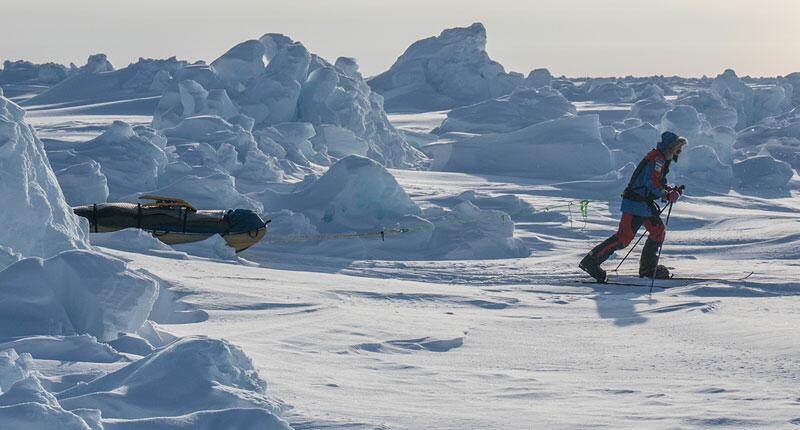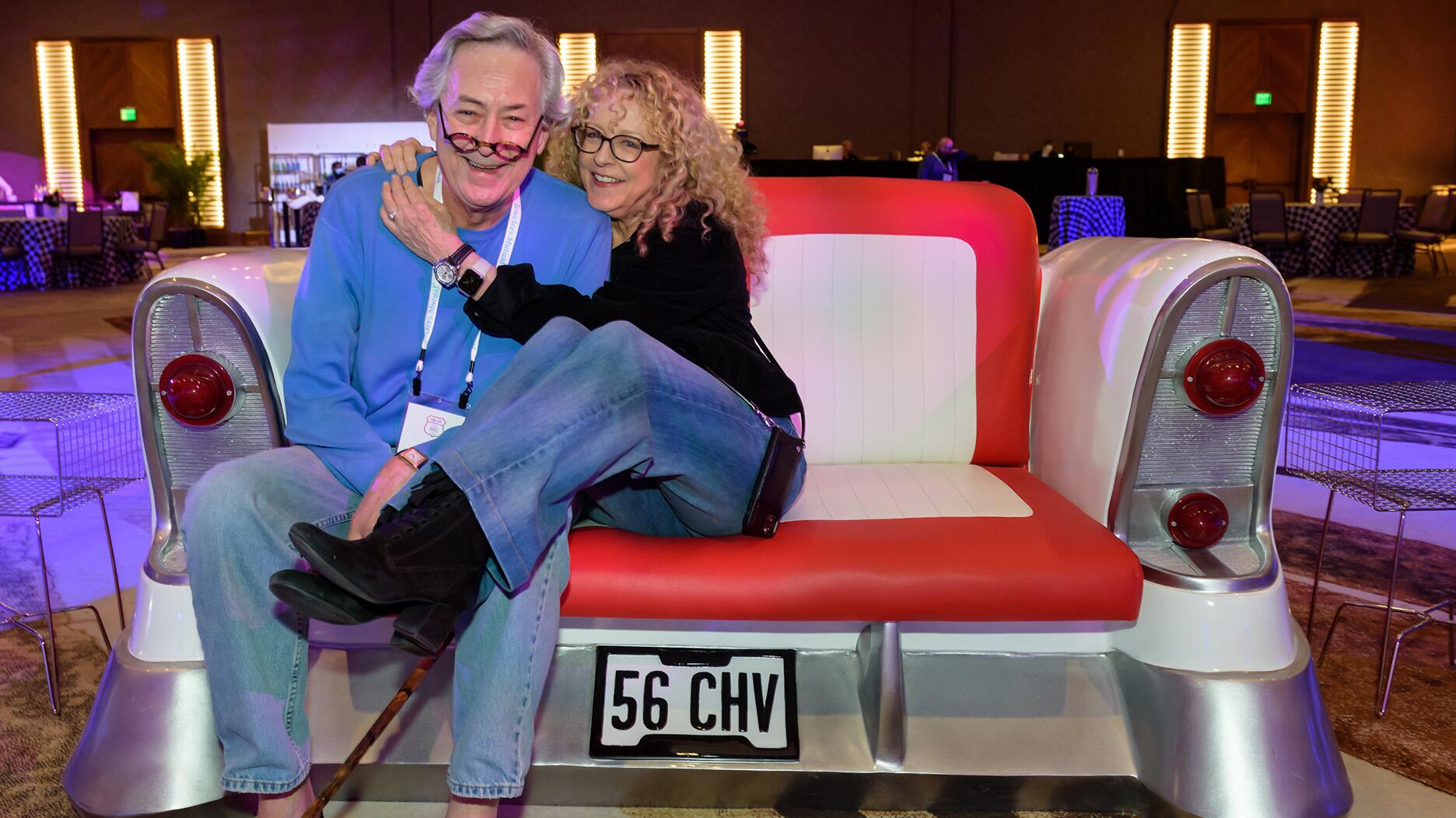The luxury goods company said founder Ippolita Rostagno will remain at the brand’s helm.
5 Lessons Learned from a Polar Explorer
Eric Larsen is one of only about 50 people to ever make an unaided trek to the North Pole. Editor-in-Chief Michelle Graff recounts what she learned from listening to him talk.

File this one under events that are cool (no pun intended).
On Wednesday, I made my way uptown to 43rd Street and Broadway in Manhattan at the invite of Citizen, which was having a special journalists-only event at its store featuring Eric Larsen.
Larsen is an author, educator and polar explorer who, in 2014, reached the geographic North Pole with his partner, Ryan Waters. They trekked from the northern most point of North America, Cape Discovery, to the geographic North Pole.
It was a trip of 480 miles over shifting sea ice that they traversed using skis, snowshoes and even swimming through open water at times, all the while lugging two sleds initially packed with 325 pounds of gear each in temperatures that hovered around 40 degrees below zero.
The duo are only the second American team in history to reach the North Pole on an unsupported and unaided quest, and two of the fewer than 50 people known to have done so in history. To put it in perspective, that’s about 5,950 people fewer than have climbed Mount Everest.
Larsen has since penned a book about this experience, “On Thin Ice: An Epic Final Quest Into The Melting Arctic,” and celebrated its launch at the Citizen store.
Though Larsen is not an official “ambassador” for the watch brand, he has worked with Citizen before, speaking at its stores and even wearing its watches on some of his treks. At the back of the store on 43rd and Broadway, you can see a collection of Larsen’s expedition photographs, a few of which incorporate his Citizen watch.
I find dangerous expeditions fascinating; to be more specific, I find hearing and reading about them fascinating (I burned through “Into Thin Air” in two days) but probably would be dead weight if I ever got invited to go on one.
Larsen’s recounting of his North Pole trek did not disappoint.
Here’s what I took away from his talk and from speaking with him briefly afterward.
He made it to the North Pole because of teamwork. During the talk, Larsen mentioned how he and Waters took turns being the leader. There were days when Waters was feeling low and Larsen would pick him up and vice versa.
After his talk, he elaborated on this a bit more for me.
“I
He explores for a reason, and it’s a good one. The subtitle of Larsen’s book is “An Epic Final Quest Into the Melting Arctic,” and I think now would be a good time to mention that the 2014 trek was not his first trip to the North Pole; it was his third.
He also made the journey in 2006 and 2010, and noted the breaking up and melting of the sea ice over time. And that is why he explores, so he can share his observations and draw attention to the changing environment.
During his talk, he evoked an old quote attributed to British mountaineer George Mallory, who died trying to summit Everest in 1924, used to explain explorers’ motivations: “Because it’s there.”
Today, Larsen says, explorers have a different reason for trekking to places like the North Pole--because it may not be there in the future.
“We are now in a position not of being first in many of these iconic adventures but of being last. And that’s a very sad thing,” he said.

“Even a bad decision is better than no decision.” This was a good thing for me to hear as I am often paralyzed by indecision, for reasons I cannot explain.
Many times along their journey, Waters and Larsen were faced with the choice of either going up and over or around obstacles, each of which presented its own unique challenges.
But in order to keep moving forward, they had to pick something.
“Oftentimes,” Larsen said, “we would remind ourselves, out loud to each other, ‘Be decisive, confident, safe,’ because at this point even a bad decision is better than no decision.”
You have to take things one day at a time and just keep going. Larsen and Waters had a limited amount of fuel (for the fire they used to cook and dry their clothes at night) and food, and also a hard date for their return. They started on March 15 and the flight company said they could pick them up no later than early May because, after that, the ice would become too unstable to land a plane.
Between day one and 18, Larsen said they averaged less than 3 miles a day; at that rate, it would have taken then 129 days to reach the North Pole, much more than the time they had left at that point.
“To get to the North Pole for us at this moment seemed impossible. And we didn’t think we could make it, yet we still kept trying to get to the North Pole. And a big part of that was simply our routine.”
The pair had to remain very focused on time. They’d wake up at a certain time, get out of the tent at a certain time, trek for a certain amount of time and take a break for a certain out of time. Efficiency, Larsen noted, was huge.
“We didn’t know if we were going to make it but we just used every day. All this helped us whittle away at that huge goal, which we thought was impossible.”
Sometimes, reaching a long-held goal can be anticlimactic. To end his speech, Larsen recounted the last day of their trek during which they journeyed for eight hours before reaching the flat sheet of ice that their GPS told them was the geographic North Pole.
After that long, arduous journey it was, “the biggest moment of anticlimax I’ve ever had in my entire life,” he said.
Larsen said you’re only at the actual North Pole for a few seconds before the drifting ice carries you away.
What’s more, there’s just nothing there, not even a marker. Stranger still, if Larsen’s tale is to be believed, there were no elves, reindeer or Clauses either.
“On Thin Ice” is available online on websites like Amazon, Barnes & Noble, etc., though I always try to buy via my friendly neighborhood bookstore in Brooklyn, Greenlight. I would encourage independent jewelers who are trying to make it amid the ever-growing crush of chain stores and e-tailers to do the same.
You can learn more about Larsen and his polar explorations at EricLarsenExplore.com.
The Latest

Laura Burdese, who joined the Italian luxury brand in 2022, will take on the role in July.

Need a gift for the cat lover who has everything? Look no further than our latest Piece of the Week.

How Jewelers of America’s 20 Under 40 are leading to ensure a brighter future for the jewelry industry.

It purchased the “Grosse Pièce,” an ultra-complicated Audemars Piguet pocket watch from the ‘20s, for a record-breaking price at Sotheby’s.


The lab-grown diamond grower now offers custom engagement and fashion jewelry through its Kira Custom Lab Jewelry service.

The boutique is slated to open this week inside Terminal 8, offering pre-owned Rolex watches and more to international travelers.

Roseco’s 704-page catalog showcases new lab-grown diamonds, findings, tools & more—available in print or interactive digital editions.

Sponsored by Digital Monitoring Products

The special-edition egg pendant ingested in a New Zealand jewelry store was recovered after a six-day wait.

Associate Editor Natalie Francisco plays favorites with Piece of the Week, selecting a standout piece of jewelry from each month of 2025.

The “Love and Desire” campaign is inspired by the magic that follows when one’s heart leads the way, said the brand.

Two awardees will receive free tuition for an educational course at the Swiss lab, with flights and lodging included.

Berta de Pablos-Barbier will replace Alexander Lacik at the start of January, two months earlier than expected.

Sotheby’s held its first two jewelry sales at the Breuer building last week, and they totaled nearly $44 million.

Winners will receive free registration and lodging for its fourth annual event in Detroit.

Here are six ideas for making more engaging content for Instagram Reels and TikTok, courtesy of Duvall O’Steen and Jen Cullen Williams.

The honorees include a notable jewelry brand, an industry veteran, and an independent retailer.

Carlos Jose Hernandez and Joshua Zuazo were sentenced to life without the possibility of parole in the 2024 murder of Hussein “Sam” Murray.

Yood will serve alongside Eduard Stefanescu, the sustainability manager for C.Hafner, a precious metals refiner in Germany.

The New Orleans jeweler is also hosting pop-up jewelry boutiques in New York City and Dallas.

Set in a Tiffany & Co. necklace, it sold for $4.2 million, the highest price and price per carat paid for a Paraíba tourmaline at auction.

The jeweler’s “Deep Freeze” display showcases its iconic jewelry designs frozen in a vintage icebox.

Take luxury gifting to new heights this holiday season with the jeweler’s showstopping 12-carat sphene ring.

This year's theme is “Unveiling the Depths of the Ocean.”

In its annual report, Pinterest noted an increase in searches for brooches, heirloom jewelry, and ‘80s luxury.

Starting Jan. 1, customers can request the service for opal, peridot, and demantoid garnet.


























